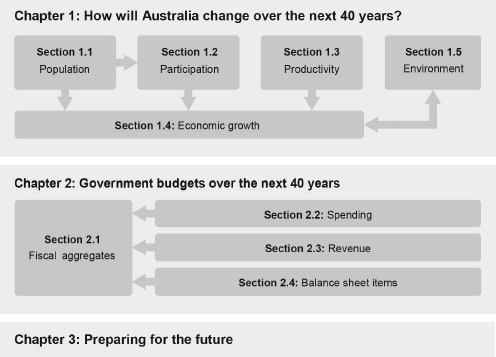Every five years, the Australian Government is required to produce an Intergenerational Report. These reports assess the long–term sustainability of current Government policies and how changes to Australia's population size and age profile may impact economic growth, workforce and public finances over the following 40 years.
Each report provides projections adopting a 'point–in–time' format—that is, using the assumption that current government policies will continue over the next 40 years, without change.
The 2015 Intergenerational Report is the fourth intergenerational report (previous reports were released in 2002, 2007 and 2010). It provides important information and analysis that can help everyone consider what policies Australia needs going forward.
The 2015 Intergenerational Report presents what could happen to Australia over the next 40 years based on a detailed analysis of recent trends and existing policy settings. The report is broken up into a number of sections which consider different aspects of the outlook—Australia's population, our labour force, the economy, the budget, the environment and what governments can do to address the challenges of the next 40 years.
These stories are interlinked, because what is happening to Australia's population will affect the economy, the economy will affect the budget, and so on. The chart below shows how the different chapters of the document relate to each other.
Chart 1: The structure of this report

Chapter 1 contains projections for the economy over the next 40 years. There are five main parts to this story:
Section 1.1 focuses on the outlook for the population over the next 40 years.
Section 1.2 explains what is expected to happen to the labour force, workforce participation and jobs.
Section 1.3 focuses on productivity, how much more efficient we are expected to get at producing goods and services and creating value.
Section 1.4 brings all these elements together to examine the outlook for the economy, and how incomes will grow along with it.
Section 1.5 is about the environment, and how it might change over the next 40 years.
Chapter 2 focuses on how the Australian Government's budget will adjust over the next 40 years. There are four parts to this story.
Section 2.1 looks at the overall budget position.
Section 2.2 looks at Australian Government spending, and the important components including health, assistance to older Australians and payments to individuals.
Section 2.3 shows how revenue is projected to change over the next 40 years.
Section 2.4 looks at the balance sheet of the Australian Government, and how the major liabilities such as debt and public sector superannuation are expected to change.
Finally, Chapter 3 looks at the different options for responding to the challenges and opportunities of the next 40 years.
Understanding long–term projections
All projections are inherently uncertain, particularly over long timeframes. This report presents projections based on current stated policy settings, assumptions and historical trends, using the 2014–15 Mid-Year Economic and Fiscal Outlook (MYEFO) as the base for the first four years of the projections.
Over the rest of the report's 40 year projections, various simplifying assumptions are used, which reflect the long–term averages of key variables like growth and productivity, or the long–term trends of variables like participation.
The projections of the budget position take into account how spending per person is likely to change for different age groups based on current policy, and then use the expected age structure of the population to work out total spending, which in turn can be used to work out the overall budget position over the next 40 years.
The projections in this report are very unlikely to unfold over the next 40 years exactly as outlined. Things will happen that are not anticipated in the report's assumptions, and government policy will change. The projections are not intended to be a prediction of the future as it will actually be, rather they are designed to capture some of the fundamental trends that will influence economic and budgetary outcomes should policies remain similar to current settings. They help to inform us about where there are opportunities to be seized, and where there are challenges to be overcome.
Successive intergenerational reports have been important in focusing public attention on some of Australia's longer term challenges and spurring some significant policy adjustments even as other long–term challenges have developed.